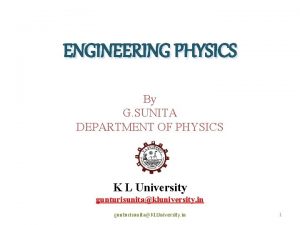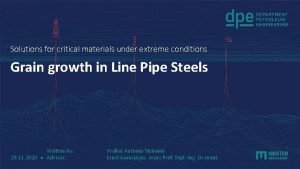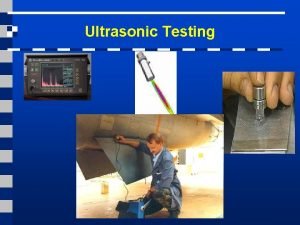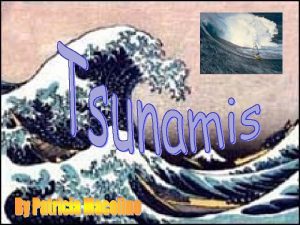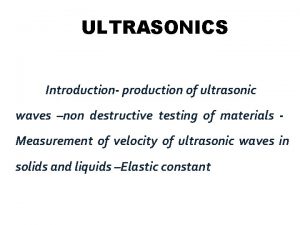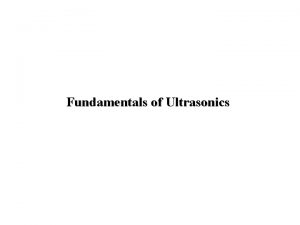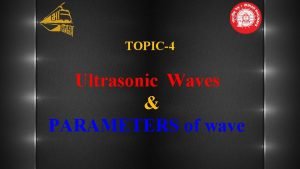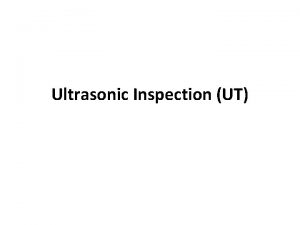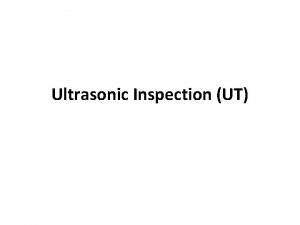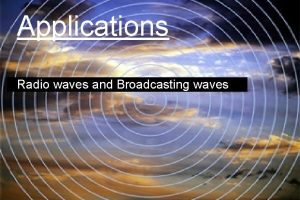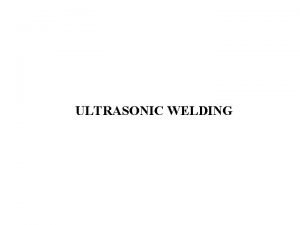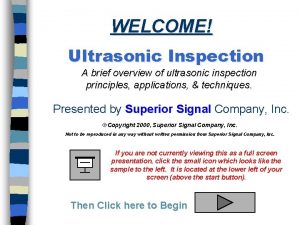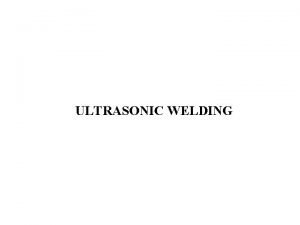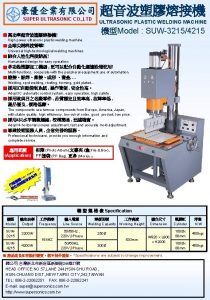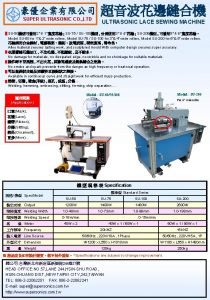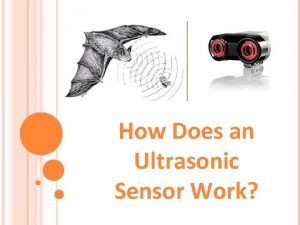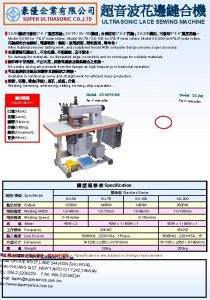ULTRASONICS Production Applications Ultrasonic waves The word ultrasonic


































- Slides: 34

ULTRASONICS Production &Applications

Ultrasonic waves The word ultrasonic combines the Latin roots ultra, meaning ‘beyond’ and sonic, or sound. The sound waves having frequencies above the audible range i. e. above 20000 Hz are called ultrasonic waves. Generally these waves are called as high frequency waves.

Types of ultrasonic waves Longitudinal waves Shear waves Direction of particle is the same direction of wave propagation, Direction of particle is perpendicular to the direction of wave propagation Surface waves transmitted on the surface of the solid


Properties of ultrasonic waves They have a high energy content Just like ordinary sound waves, ultrasonic waves get reflected, refracted and absorbed They can be transmitted over large distances with no appreciable loss of energy. If an arrangement is made to form stationary waves of ultrasonics in a liquid, it serves as a diffraction grating. It is called an acoustic grating. Acoustic cavitation refers to ultrasonically induced bubble activity occurring in a biological material that contains pre-existing gaseous inclusions

ACOUSTIC CAVITATION • cavitation is the phenomenon where small and largely empty cavities are generated in a fluid, which expand to large size and then rapidly collapse. When the cavitation bubbles collapse, they focus liquid energy to very small volumes. Thereby, they create spots of high temperature and emit shock waves. The collapse of cavities involves very high energies. ultrasound enhances chemical and physical changes in a liquid medium through the generation and subsequent destruction of cavitation bubbles.


Production of Ultrasonic waves produced by two methods Piezoelectric Effect Magnetostriction

Magnetostriction Effect • When a ferromagnetic rod like iron or nickel is placed in a magnetic field parallel to its length, the rod experiences a small change in its length. This is called magnetostricion effect.

The change in length (increase or decrease) produced in the rod depends upon the strength of the magnetic field, the nature of the materials and is independent of the direction of the magnetic field applied.

Magnetostriction oscillator

• XY is a rod of ferromagnetic materials like iron or nickel. The rod is clamped in the middle. • The alternating magnetic field is generated by electronic oscillator. • The coil L 1 wound on the right hand portion of the rod along with a variable capacitor C. • This forms the resonant circuit of the collector tuned oscillator. The frequency of oscillator is controlled by the variable capacitor. • The coil L 2 wound on the left hand portion of the rod is connected to the base circuit. The coil L 2 acts as feed – back loop.

Working • When High Tension (H. T) battery is switched on, the collector circuit oscillates with a frequency, f= • This alternating current flowing through the coil L 1 produces an alternating magnetic field along the length of the rod. The result is that the rod starts vibrating due to magnetostrictive effect.

The frequency of vibration of the rod is given by n = where l = length of the rod Y = Young’s modulus of the rod material and =density of rod material • The capacitor C is adjusted so that the frequency of the oscillatory circuit is equal to natural frequency of the rod and thus resonance takes plate. • Now the rod vibrates longitudinally with maximum amplitude and generates ultrasonic waves of high frequency from its ends.

Advantages 1. 2. The design of this oscillator is very simple and its production cost is low At low ultrasonic frequencies, the large power output can be produced without the risk of damage of the oscillatory circuit. Disadvantages 1. It has low upper frequency limit and cannot generate ultrasonic frequency above 3000 k. Hz (ie. 3 MHz). 2. The frequency of oscillations depends on temperature. 3. There will be losses of energy due to hysteresis and eddy current. PH 0101 UNIT 1 LECTURE 6 15

Piezo- electric effect When the opposite faces of a crystal like Quartz, Tourmaline, are subjected to pressure, a potential difference is developed across the perpendicular opposite pair of faces – equal and opposite electric charges are developed. The potential difference is proportional to the amount of pressure or stress. This is direct piezo-electric effect. If the crystal is subjected to tension, the polarities of the charges reversed. The converse is also true. If an a. c voltage is applied to one pair of faces of the crystal, alternate mechanical contractions and expansions are produced on the opposite pair of faces and the crystal starts vibrating. If the frequency of the a. c voltage is equal to the natural frequency of the crystal, resonance takes place, producing ultrasonic waves of large amplitude.

Piezo-electric crystal : Natural quartz crystal has the shape of a hexagonal prism with a pyramid attached to each end. The line joining the apex points of the pyramids is the optic axis ( the z axis ). The three lines which pass through the opposite corners of the crystal constitute its three electrical axes ( the three X axes). The three lines which are the perpendicular to the sides of the hexagon form the mechanical axes (the Y axes). A thin plate of the crystal cut perpendicular to one of its X axes is known as an X – cut plate. A thin plate cut perpendicular to one of the Y axes is known as a Y-cut plate. An X-cut plate may be kept fixed between two parallel metal plates and a suitable a. c voltage may be applied across the metal plates. If the a. c voltage is applied along the electrical axis (Y axis), the crystal vibrates along the mechanical axis ( Y axis ).


Piezo Electric Generator or Oscillator Principle : Inverse Piezo electric effect If mechanical pressure is applied to one pair of opposite faces of certain crystals like quartz, equal and opposite electrical charges appear across its other faces. This is called as Piezo-electric effect. • The converse of Piezo electric effect is also true. • If an electric field is applied to one pair of faces, the corresponding changes in the dimensions of the other pair of faces of the crystal are produced. This is known as inverse Piezo electric effect or electrostriction. •

Piezo electric oscillator

• The quartz crystal is placed between two metal plates A and B. • The plates are connected to the primary (L 3) of a transformer which is inductively coupled to the electronics oscillator. • The electronic oscillator circuit is a base tuned oscillator circuit. • The coils L 1 and L 2 of oscillator circuit are taken from the secondary of a transformer T. • The collector coil L 2 is inductively coupled to base coil L 1. • The coil L 1 and variable capacitor C 1 form the tank circuit of the oscillator.

Working • When H. T. battery is switched on, the oscillator produces high frequency alternating voltages with a frequency. • Due to the transformer action, an oscillatory e. m. f. is induced in the coil L 3. This high frequency alternating voltages are fed on the plates A and B. • Inverse piezo-electric effect takes place and the crystal contracts and expands alternatively. The crystal is set into mechanical vibrations. • The frequency of the vibration is given by n = where P = 1, 2, 3, 4 … etc. for fundamental, first over tone, second over tone etc. , Y = Young’s modulus of the crystal and ρ = density of the crystal. 22

• The variable condenser C 1 is adjusted such that the frequency of the applied AC voltage is equal to the natural frequency of the quartz crystal, and thus resonance takes place. • The vibrating crystal produces ultrasonic waves of large amplitude. longitudinal

Advantages • Ultrasonic frequencies as high as 5 x 108 Hz or 500 MHz can be obtained with this arrangement. • The output of this oscillator is very high. • It is not affected by temperature and humidity. Disadvantages • The cost of piezo electric quartz is very high • The cutting and shaping of quartz crystal are very complex.


Non Destructive Testing –NDT Ultrasonic waves are used to detect the presence of flaws or defects in the form of cracks, blowholes porosity etc. , in the internal structure of a material By sending out ultrasonic beam and by measuring the time interval of the reflected beam, flaws in the metal block can be determined

Experimental setup It consists of an ultrasonic frequency generator and a cathode ray oscilloscope (CRO), transmitting transducer(A), receiving transducer(B) and an amplifier.

Working • In flaws, there is a change of medium and this produces reflection of ultrasonic at the cavities or cracks. • The reflected beam (echoes) is recorded by using cathode ray oscilloscope. • The time interval between initial and flaw echoes depends on the range of flaw. • By examining echoes on CRO, flaws can be detected and their sizes can be estimated.

Features • This method is used to detect flaws in all common structural metals and other materials like rubber tyres etc. • The method is very cheap and of high speed of operation. • It is more accurate than radiography. PH 0101 UNIT 1 LECTURE 6 29

Ultrasonic Drilling • Ultrasonics are used for making holes in very hard materials like glass, diamond etc. • For this purpose, a suitable drilling tool bit is fixed at the end of a powerful ultrasonic generator. • Some slurry (a thin paste of carborundum powder and water) is made to flow between the bit and the plate in which the hole is to be made • Ultrasonic generator causes the tool bit to move up and down very quickly and the slurry particles below the bit just remove some material from the plate. • This process continues and a hole is drilled in the plate.

Ultrasonic welding • The properties of some metals change on heating and therefore, such metals cannot be welded by electric or gas welding. • In such cases, the metallic sheets are welded together at room temperature by using ultrasonic waves.

Ultrasonic soldering • Metals like aluminium cannot be directly soldered. However, it is possible to solder such metals by ultrasonic waves. • An ultrasonic soldering iron consists of an ultrasonic generator having a tip fixed at its end which can be heated by an electrical heating element. • The tip of the soldering iron melts solder on the aluminium and the ultrasonic vibrator removes the aluminium oxide layer. • The solder thus gets fastened to clear metal without any difficulty.

Ultrasonic cutting and machining Ultrasonic waves are used for cutting and machining. Ultrasonic cleaning It is the most cheap technique employed for cleaning various parts of the machine, electronic assembles, armatures, watches etc. , which cannot be easily cleaned by other methods.

Applications of Ultrasonics in Medicine Diagnostic sonography • Medical sonography (ultrasonography) is an ultrasound-based diagnostic medical imaging technique used to visualize muscles, tendons, and many internal organs, their size, structure and any pathological lesions. • They are also used to visualize the foetus during routine and emergency prenatal care. Ultrasound scans are performed by medical health care professionals called sonographers. Obstetric sonography is commonly used during pregnancy.
 Production of ultrasonic waves by magnetostriction method
Production of ultrasonic waves by magnetostriction method Symmectric
Symmectric Laser ultrasonics
Laser ultrasonics Multimedia content production adalah
Multimedia content production adalah Application of ultrasonic testing
Application of ultrasonic testing What waves do not require a medium
What waves do not require a medium Light waves are electromagnetic waves true or false
Light waves are electromagnetic waves true or false Mechanical wave and electromagnetic wave
Mechanical wave and electromagnetic wave Similarities of mechanical waves and electromagnetic waves
Similarities of mechanical waves and electromagnetic waves The wave chapter 13
The wave chapter 13 Is echolocation transverse or longitudinal
Is echolocation transverse or longitudinal Short wave vs long wave radiation
Short wave vs long wave radiation Mechanical waves and electromagnetic waves similarities
Mechanical waves and electromagnetic waves similarities Mechanical vs electromagnetic waves
Mechanical vs electromagnetic waves Mechanical waves and electromagnetic waves similarities
Mechanical waves and electromagnetic waves similarities Surface waves and body waves
Surface waves and body waves Is a seismic wave mechanical or electromagnetic
Is a seismic wave mechanical or electromagnetic Compare and contrast p waves and s waves using venn diagram
Compare and contrast p waves and s waves using venn diagram Mechanical wave and electromagnetic wave
Mechanical wave and electromagnetic wave What are constructive waves
What are constructive waves Ow sound
Ow sound Meaning of harbour wave
Meaning of harbour wave Quadratic applications word problems
Quadratic applications word problems Hát kết hợp bộ gõ cơ thể
Hát kết hợp bộ gõ cơ thể Ng-html
Ng-html Bổ thể
Bổ thể Tỉ lệ cơ thể trẻ em
Tỉ lệ cơ thể trẻ em Gấu đi như thế nào
Gấu đi như thế nào Tư thế worm breton
Tư thế worm breton Chúa yêu trần thế
Chúa yêu trần thế Môn thể thao bắt đầu bằng chữ f
Môn thể thao bắt đầu bằng chữ f Thế nào là hệ số cao nhất
Thế nào là hệ số cao nhất Các châu lục và đại dương trên thế giới
Các châu lục và đại dương trên thế giới Công thức tiính động năng
Công thức tiính động năng Trời xanh đây là của chúng ta thể thơ
Trời xanh đây là của chúng ta thể thơ
